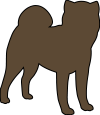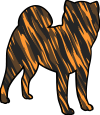This two-part genetics series will introduce the fundamentals of heredity and genetics and how a dog’s genetic code determines its outward appearance. We’ll cover some basic principles and terminology in the first part, and go over probability of inheritance and litter statistics in the second part.
Already know the basics and want all the glorious tables and diagrams? Click here to skip to part two.
It has come to my attention that some disreputable sources are referencing these articles, so be aware that brown (aka liver or chocolate), dilute (aka blue), lilac (aka isabella), merle, and any other colors or patterns not specifically mentioned in this article are not native to the Japanese breeds and is the direct result of mixing with other breeds. In addition, except for merle, these colors can only occur if both parents are mixed.
Introduction to Genetics
All living creatures have a unique combination of characteristics, or traits, that are different from any other’s. Some traits affect an individual’s physical appearance, like coat color and height. Others are less visible, like obeisance, prey drive, and resistance to disease. Traits are often inherited, but almost always affected by interaction with the environment. For example, fur color can be affected by sunlight, bleach, or dye, or a dog that has a natural tendency to be large might be small due to poor nourishment a puppy.
Genetics is the study of heredity, or how traits are passed on from parents to offspring. A long molecule called DNA carries genetic information which is copied and inherited across generations. A gene is one section of a DNA molecule that tells a cell to perform one specific task. The different forms of a gene are called alleles. In dogs, for instance, there are two alleles for coat length. One allele is for short hair, while the other is for long hair. The alleles a dog inherited from its parents determines the length of its coat.
Complex organisms like humans and dogs have two copies of each of their genes (i.e. two alleles) in all of their normal cells. In preparation for sexual reproduction, sperm or egg cells are produced that only contain one copy of each gene. Their genes are shuffled, or recombined, during this process. An egg then joins with a sperm to create an offspring with a new set of genes. The offspring will also have two copies of each gene like its parents, but with one allele from its mother and the other from its father.
The gene composition of an individual is its genotype, while its outward expression of those genes combined with environmental influences is its phenotype.
Dominance, Recessiveness, and Epistasis
Although a dog has two alleles for each gene, only one copy is expressed in its phenotype. The other copy lies dormant and has little or no effect on the individual. Which allele is expressed depends on the order of dominance for the alleles of that gene. The more dominant allele will suppress the expression of the recessive allele. When a gene has more than two possible alleles, they are ranked in order from most dominant to most recessive.
On rare occasions, both alleles will be expressed. Codominance occurs when two different genotypes are expressed together in the phenotype, like blue and yellow create blue and yellow stripes. Incomplete dominance occurs when two genotypes produce a third unique phenotype, like blue and yellow mix to create green. In general, the expression of incomplete dominance will lean towards the more dominant allele.
In some cases, the effect of one gene can mask or modify the effect of another gene. Epistasis occurs when two or more genes contribute to the same phenotype. For example, hairlessness is epistatic to the genes for coat color; it supersedes coat color by preventing the growth of hair. A hairless dog still has a coat color genotype, but it cannot be expressed in its phenotype. Because this is the interaction between different genes, rather than alleles of the same gene, epistasis is outside the order of dominance.
Two Types of Pigment
Genes at several locations, or loci, within a dog’s DNA control hair and skin color. These genes produce cells called melanocytes which contain deposits of pigment called melanin. The great variety of canine coat colors and patterns are created by two basic types of pigment, eumelanin (black pigment) and pheomelanin (red pigment). All of the variations in color are created by these two forms of melanin and the density of melanocytes.

Types of eumelanin – black, brown, dilute, and lilac
The default color of eumelanin is black but its shade and tone can be modified by genes which make it brown (aka chocolate or liver) or dilute (aka blue), and dilute brown eumelanin creates a dusky tan color called lilac (aka isabella). Eumelanin can be found in all parts of a dog that need pigment, including the nose, skin, irises, and internal structures of the ears and eyes. Not all dogs have eumelanin in their coat, but the shade of a dog’s eumelanin can be determined by looking at its nose. All dogs must be genetically black, dilute, brown, or lilac regardless of coat color.

Intensity of pheomelanin from dark to light
Unlike eumelanin, pheomelanin only affects hair color. By default, dogs do not possess the ability to express pheomelanin at all, but some alleles can switch on the production of red pigmented melanocytes in the hair. Like red hair in humans, these alleles are recessive. Pheomelanin comes in a wide range of shades including cream, apricot, blonde, gold, tan, burnt orange, and copper. The term red applies to all of these colors and everything in between.
Genes not only control production of melanin but also its distribution. The more melanocytes in an area, the darker and richer the pigment will be; where there are few melanocytes, the pigment is lightened. White hair, pink skin, and blue eyes are not caused by either type of melanin but rather the lack of it. Albinism is the complete absence of pigment in the skin, hair, and eyes, while white markings are the absence of pigment on just some parts of the animal. The many shades of red, from near-white to dark chestnut, are caused by the distribution and density of pheomelanin.
Coat Colors of Japanese Breeds
The native breeds of Japan come in five basic coat colors: red, sesame, black and tan, brindle, and white. Each of the breeds contains only a subset of these colors, except for the Hokkaido Ken which has all five. The Japanese name and official phenotype for these colors are listed below, but this document will use the breed specific colors for simplicity. The interaction of three separate genes control all five colors. While there are other coat color genes and multiple alleles at each of these loci, only those present in the Japanese breeds will be addressed.
| Color | Japanese | Phenotype | Breeds |
|---|---|---|---|
| Red | Aka | Sable | Akita, Hokkaido, Kishu, Shiba, Shikoku |
| Sesame | Goma | Agouti | Hokkaido, Kishu, Shiba, Shikoku |
| Black and Tan | Kuro | Tan Point | Hokkaido, Shiba, Shikoku |
| Brindle | Tora | Brindle | Akita, Hokkaido, Kai |
| White | Shiro | Recessive Red | Akita, Hokkaido, Kishu, Shiba |
A Japanese dog’s base pattern is determined by the Agouti Series (A Locus). There are three alleles at this locus: red (Ay), sesame (aw), and black and tan (at) in order of most dominant to most recessive. Red is dominant over sesame, which in turn is dominant over black and tan. A dog with at least one Ay allele is red, a dog with at least one aw allele and no Ay allele is sesame, and a dog with two at alleles is black and tan. Dogs can only carry one hidden allele at each locus, which means a red dog can carry sesame or black and tan but not both. The base pattern can be partially or completely obscured by brindle or white at the K Locus and E Locus respectively.
| Red | Sesame | Black & Tan | |||
|---|---|---|---|---|---|
 |
 |
 |
 |
 |
 |
| AyAy | Ayaw | Ayat | awaw | awat | atat |
Whether a dog is brindle or non-brindle is determined by the Dominant Black Series (K Locus). Of these two alleles, brindle (kbr) is dominant over non-brindle (ky). Brindle stripes only affect red pigmented areas of the dog, so when combined with black and tan only the legs and cheeks are brindle. These “brindle point” dogs are registered as black and tan because they’re predominantly black. No distinction is made between brindle overlaying red, which is most common, or brindle overlaying sesame; both are registered as brindle. Brindle can be completely obscured by white at the E Locus.
| Brindle | Non-Brindle | |
|---|---|---|
 |
 |
 |
| kbrkbr | kbrky | kyky |
The Extension Series (E Locus) controls whether a dog has colored coat determined by other loci or is solid white. Colored (E) is the default or “wild type” allele and dominant over white (e). A dog with at least one E allele expresses its color normally, and a dog with two e alleles is white. These white dogs are incapable of producing any black pigment in their hair, including whiskers and eyelashes. However, some faint red pigment may still be present, especially on the edges of the ears, shoulders, or back of the legs.
| Colored | White | |
|---|---|---|
 |
 |
 |
| EE | Ee | ee |
It is important to understand that all dogs have genes at these loci even when those genes are not visible. Because white is the absence of pigment, the E Locus is epistatic to all other coat color genes. White dogs still possess brindle or non-brindle alleles at the K Locus and red, sesame, or black and tan alleles at the A Locus – but they are hidden.
Other Traits: Long Coat
The coat length of a Japanese dog is determined by the Long Hair Series (L Locus). Short coat (L) is dominant over long coat (l). A dog with at least one L allele has normal coat length for its breed and a dog with two l alleles has long coat. However, the short coat allele has incomplete dominance; when a short coated dog carries a long coat allele, it tends to have a fuller and more plush coat than a dog with two short coat alleles. These carriers are often lauded for their great coats in conformation shows, leading to breeding more carriers and long coated puppies.
